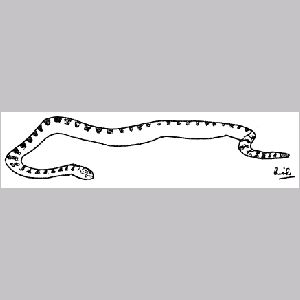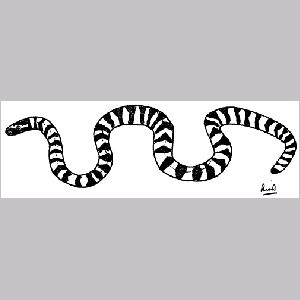http://140.247.119.138/mantis/Sea Snakes in the Waters of the United Arab Emirates
Sea Snakes in the Waters of the United Arab Emirates
by J.N.B.BrownIn March 1986 1 found two sea-snakes alive but stranded on the beach about 3 km west of Jebel Ali Hotel (24°58'N, 55°02'E). After taking photographs I returned both specimens to their natural habitat in the sea, as they are virtually immobile on land. The larger one swam off at the second attempt, but the smaller one was unable to combat the incoming waves and was continually returned to the beach. It was obvious that it would not have survived, so though I was loath to kill it, I preserved it to obtain a positive identification.
The larger sea snake was identified as a Reef Sea-snake (Hydrophis ornatus) and the smaller one as an Arabian Gulf Sea-snake (H. lapemoides). There are about 50 recorded species of sea snake in the world and most occur, and probably evolved, in the warm South Asian and Australian coastal waters. Possibly nine species have so far spread to the shores of the UAE, in both the Gulf of Oman and the Arabian Gulf. The only other sea snake I have identified is the Yellow-bellied Sea-snake (Pelamis platurus), several specimens having been found on beaches around Abu Dhabi.
Most sea snakes remain in shallow waters, except P. platurus that is known to move across oceans and deep water. They never come ashore voluntarily because their oval-shaped bodies cause them to flop over onto their sides when out of water. They have lost the broad ventral scales on the underside that help snakes move on land. The tail is vertically compressed to help with movement through the water.
Sea snakes can stay under water for periods up to two hours before rising to the surface for air. The left lung has virtually disappeared, leaving a very long right lung, which also incorporates an air sac to store air and aid buoyancy. Small valves close off the nostrils to prevent the ingress of seawater. There are no openings for eardrums and the eyes have a spectacle eye covering. The young are born live in the water and must rise to the surface quickly to breathe air.
The venom of all sea snakes is extremely toxic to humans, so they should all be considered dangerous. Poison is generally injected through hollow fangs situated on each side at the front of the mouth. Back-up fangs usually grow behind the main ones to replace them if they are broken or lost. This replacement takes place throughout the life of the snake. The venom is of the neurotoxic type and is said to be nearest to cobra venom.
Food probably consists entirely of fish caught in crevices and holes. In some sea snake species the head is small and the neck elongated to facilitate access into even the smallest crevice. Although the mouth looks small and it is frequently stated that it is too small to bite a human, the gape is quite wide. Fortunately, they are not aggressive, except during the mating season.
Sea snakes are cold-blooded animals and can often be seen basking on the surface to get warm. P. platurus is reported to lie on the surface pretending to be a piece of wood, which attracts fish that subsequently become food. They shed their skin every three or four weeks, more frequently than land snakes. This aids the removal of barnacles and other invertebrates from the skin.
Hydrophis ornatus (Reef Sea-snake)The snake found at Jebel Ali was generally olive in colour with 50 dark gray to black blotches to the tip of the tail. These blotches (not full rings) spread over the back to almost halfway down each side of the body. The face and head are yellowish with large dark scales at the top. The eye pupil was black and round. The nostrils were prominent with a shutter.
The body was oval shaped and covered with small scales. Though lethargic, it was able to move the first 15 cm of the body through almost 180' on each side. Maximum length is reported as 125 cm.
The Jebel Ali specimen measured 82.5 cm total length of which the tail was 13.7 cm. The body was 4.0 cm deep at greatest depth.
Hydrophis lapemoides (Arabian Gulf Sea-snake)The specimen caught at Jebel Ali was not fully-grown, being only 42.0 cm long and 1.5 cm deep. The head was black with a whitish V shape around it, the point towards the snout. Large scales covered the head and the body was covered with rows of smaller ones. There were 49 black bands right around the body to the end of the tail, interspersed with white bands.
The snake was aggressive when moved, opening its mouth and hissing loudly. It was able to move the forward part of its body from side to side a little.
There were 11 small barnacles on the skin that could only be removed at the next slough.
The adult snake is described as yellowish to olive background with dark olive to black cross bands. The head is olive coloured. Maximum length is 96 cm.
Pelamis platurus (Yellow-bellied Sea snake)Generally black or dark brown on top and yellowish on the sides and under the belly. The dark color is mainly complete on the front third, but may break up into dark crossbars over the hind two thirds. The tail is short and flat with mottled black and yellowish markings.
Maximum length up to 110 cm. Typical measurements of collected specimens are shown thus:
| . | Specimen 1 | Specimen 2 |
| Total length | 40.2 | 28.5 |
| Snout to vent | 35.5 | 25.0 |
| Vent to tail tip | 4.7 | 3.5 |
| Length of mouth | 1.6 | 1.8 |
| Location | Corniche (Abu Dhabi) | Khalidiya (Abu Dhabi) |


